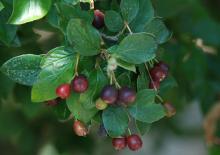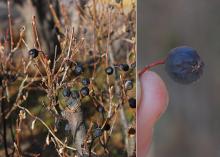Cotoneaster lucidus
Common name:
Hedge Cotoneaster
Pronunciation:
ko-toe-nee-AS-ter LU-si-dus
Family:
Rosaceae
Genus:
Type:
Broadleaf
Native to (or naturalized in) Oregon:
No
- Broadleaf deciduous shrub, erect, 6-10 ft (~2-3 m) high, somewhat less in width, round-topped, spreading branches. Leaves alternate, simple, elliptic-ovate to oblong-ovate, 2-7 cm long, shiny green and glabrous (without hairs) above, pubescent below, especially on veins, then glabrous, fall color yellow to red; petiole 2-5 mm long. Flowers pinkish, small, 3-8 per cluster (cyme), blooms in late spring. Fruit subglobose to obovoid, 8-10 mm long, black, with 3-4 nutlets; persisting into winter.
- Sun to light shade, does well in poor soil, tolerant to wind. Often used as a hedge
- Hardy to USDA Zone 3 Native to northern Asia, especially the Altai Mountains, a mountain range in central Asia, where Russia, China, Mongolia and Kazakhstan intersect.
- Dirr (1998) points out that C. lucidus is often confused with C. acutifolius, Peking Cotoneaster, but the foliage of this species is dull green and somewhat hairy in comparison to the shiny glabrous leaves of C. lucidus. Some authorities now consider C. lucidus a variety of C. acutifolius and is listed as Cotoneaster acutifolius var. lucidus (Flora of China 9:85-108. 2003).
- lucidus: bright, shining.









